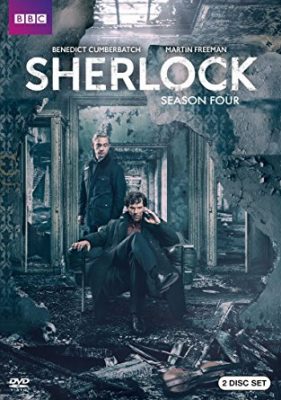
The return of Sherlock after an absence of two years – not counting the one-off The Abominable Bride – set audience records then dropped off precipitously. Of its three 90-minute episodes, one was brilliant, one was much better than the average mystery/procedural and the final had great moments but also a number of obvious flaws.
If you binge all three episodes, though, it is easily apparent that Sherlock’s worst was better than most shows’ best – as the fourth season DVD set shows. Plus there’s two hours of pretty darned decent bonus material.
Season four opening with The Six Thatchers, in which the destruction of busts of late Prime Minister Margaret Thatcher were destroyed. While calling a famous a famous canonical tale, The Six Napoleons, to mind, the episodes of vandalism led to a much larger story involving Mary Watson’s (Amanda Abbington) past in the world of espionage and assassination.
Next up, The Lying Detective found Sherlock (Benedict Cumberbatch) and John (Martin Freeman) estranged as a result of the events of the season premiere – and Sherlock feeding his drug addiction to excess. Even off his **** on drugs, though, he’s able to discover that beloved media mogul and celebrity Culverton Smith (Toby Jones, absolutely magnificent in the role) is a serial killer. The episode ends with a twist (series creators Steven Moffat and Mark Gatiss call it ‘seismic’ – and they’re not wrong) that completely changes things.
Finally, we meet the hinted at third Holmes sibling for real and it leads to an ‘inmates have taken over the asylum’ tale called The Final Problem.
Many Sherlock fans were put off by the violence in season four, but they seem to have forgotten that Conan Doyle sprinkled a fair bit of violence and blood through the original Holmes tales. Indeed, Holmes was shown to be a first-rate bare knuckle boxer, brawler and student of the martial art baritsu. He and Watson both, on occasion employed the use of firearms.
Perhaps the death of a recent addition to the show caused more consternation that it should have, but given the character’s established background – and the fact that the character’s death was, indeed, canonical – it made perfect sense to use that background in writing that death.
The logical consequences of that death had to be the estrangement of Holmes and Watson and both The Six Napoleons and The Lying Detective are impeccable in their use of logic. Both are, in fact extremely well written and executed.
Where The Final Problem falls down is in showing us results of the villainous Holmes sibling’s plans without showing how they were achieved. There’s no glass between a cell and the visitors’ room? Where’d it go? How did that get done?
The third Holmes sibling can persuade anyone to do anything they want because they’re so clever? Show that happening!
And what about the second episode cliffhanger? That did not look like a trank gun!
Even so, the reappearance of Jim Moriarty (Andrew Scott) is a masterstroke – as are both the reason and the timing.
Equally ingenious is the way that Sherlock has remixed his childhood (apparently a mind place can have rooms that have been renovated); and the masterful use of disguise is exactly misleading enough.
Overall, for every flaw that exists in The Final Problem, there is a moment of genius. The problem is that the flaws are of the same magnitude. After the first WTF? Moment, we’re stuck with a ‘Wait! What?’ moment. (It comes as no surprise then, when in the featurette The Writer’s Chat, Moffat and Gatiss talk about how hard it was to write the first two eps and how quickly the finale came. (Perhaps a final pass to address some of the more egregious flaws wouldn’t have been out of line.)
Earlier revelations about Mrs. Hudson (Una Stubbs) and Molly Hooper (Louise Brealey) are re-emphasized to telling effect over the course of the final two episodes and it’s great to see that – and both Stubbs and Brealey are magnificent in those scenes.
There is close to two hours’ worth of bonus features (though, sadly, no commentary tracks, and the Video Diary segments are pretty much rubbish):
Behind 221B: 20-minute featurettes on the making of each episode; John and Mary’s Flat (this, people, is how you do a set tour!); Script to Screen: another extended featurette taking through the steps of making an episode – from writing to table read to building, performing, directing and post-production; The Writer’s chat (Moffat and Gatiss discuss the writing of the season); Mark Gatiss’ Video Diary Part One: On Set; Mark Gatiss’ Video Diary Part Two: Final Scenes; Danny Hargreaves Video Diary; 221B Time Lapse (the set is constructed before our eyes).
Grade: The Six Thatchers – A+
Grade: The Lying Detective – A
Grade: The Final Problem – C+
Grade: Features – B
Final Grade: B+